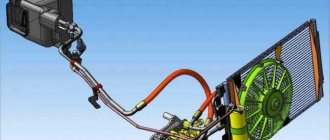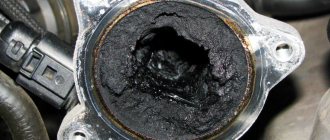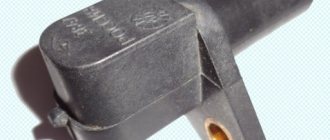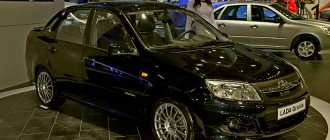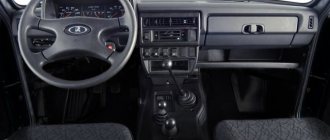Chevrolet Niva is a compact Russian SUV that went into production in 2002, but development of the model began much earlier. The car immediately gained high popularity in the country, and in 2009, a deep modernization of the Chevrolet Niva took place. The car received updated body overhangs, while structurally the model remained the same. In general, the Chevrolet Niva is already a technically outdated car. In 2014, a prototype of the second generation Niva was presented, but the new product has not yet entered production. In this regard, the release of the current Niva has been extended indefinitely.
Modifications
Chevrolet Niva (212300 - 55) first rolled off the assembly line back in 2002 and immediately gained popularity among drivers thanks to its good cross-country ability, powerful engine, reliability and low maintenance costs.
In its entire history, the car has experienced only one restyling in 2009 a modern appearance.
Niva Chevrolet 1.7 l
The heart of the Chevy Niva is the VAZ-2123 four-cylinder gasoline engine , developed on the basis of the VAZ-21214 injector back in the 90s of the last century.
Technical characteristics VAZ-2123 engine :
- volume – 1.7 liters
- power – 80 hp
- torque - 127.5 Nm (at 4000 rpm)
- maximum speed – 140 km/h
- acceleration time to 100 km – 19 seconds
The engine was updated and improved several times, was modified and transferred by designers from the Euro-2 environmental standard to modern Euro-5 standards.
Since the end of 2015, all cars have been produced only with a Euro-5 class engine.
Niva Chevrolet 1.8 l
FAM-1 (VAZ-21236) was produced from 2006 to 2008. 1.8- liter Opel Z18XE .
Its technical data was superior to the VAZ engine:
- volume – 1.8 liters
- power – 122 hp
- torque – 167 Nm (at 3800 rpm)
- maximum speed – 165 km/h
- acceleration time to 100 km – 12 sec
The cost of the Chevy Niva in this configuration was much higher, so it was not in great demand, and in less than two years it was withdrawn from the market. However, such fields still travel safely on the roads of the country.
Is there an alternative?
To save fuel, some suggest converting to gas. There is a lot of debate on this issue, however, if you agree to such a rework, you should take into account the opinions of critics:
- It is not possible to repair the engine at every service center - for service you will have to visit a specialized workshop;
- gas consumption is higher - compared to gasoline, 1.5 times more fuel is required;
- burnout of the cylinder head gasket - the standard resource of 150 thousand km can be safely divided in half;
- gas takes away power, and Niva already doesn’t have enough of it;
- cross-country ability is reduced - if a gas cylinder is installed behind the rear gearbox, it noticeably reduces ground clearance.
Practice shows that HBO is not the best option for Niva. To increase cross-country ability, some try to place the cylinder in the trunk, but the container will take up its entire volume.
Adding to the complexity is increased engine wear and reduced vehicle performance.
Still, the best option for a Chevrolet Niva is high-quality gasoline and proper care.
Fuel consumption
One of the most discussed topics among car owners is: what is the fuel consumption of the Chevrolet Niva? Let's figure it out. Consumption depends on many parameters, both on the characteristics of the car itself and on its operating conditions. Each specific car will always have its own, but there are fuel consumption standards set by the manufacturer. They are presented below, per 100 km.
Consumption of Chevrolet Niva 1.7 l Euro-2
- urban mode - 10.8 l
- highway consumption (5th gear, speed 90 km/h – 8.6 l
- highway consumption (5th gear, speed 120 km/h) – 11.6 l
Consumption of Chevrolet Niva 1.7 l Euro-5
- urban mode - 14.1 l
- highway consumption – 8.8 l
- average consumption – 10.2 l
Interestingly, the updated engine with the Euro-5 environmental standard has increased fuel consumption, but its power has remained unchanged.
Consumption of Chevrolet Niva 1.8 l
- urban mode - 12.7 l
- highway consumption – 10.4 l
- average consumption – 8 l
Niva Chevrolet 1.7 l
We can conclude that the energy consumed by the Chevrolet Niva transmission exceeds the losses caused by rolling friction in the tires.
This is bad. However, for most light SUVs everything looks exactly the same. Often gas stations try to make money from drivers by filling the tank with low-quality fuel. This entails the following consequences:
- A large amount of impurities or a low octane number of gasoline reduces engine efficiency.
- Paraffin and other contaminants found in low-grade gasoline clog injectors, filters, throttle bodies and fuel pumps.
Therefore, you need to refuel only at proven gas stations. This will help save fuel and extend engine life.
Important: Do not fill in “washing gasoline” - it is safer and more effective to flush the injectors and fuel system with special liquids. True, to do this you will have to disassemble the throttle and remove the injectors.
Various additives that reduce fuel consumption, clean injectors and increase the octane number of gasoline, at best, will not cause harm. At worst, they will clog the jets and leave carbon deposits on the spark plugs.
How to reduce fuel consumption
If you think that your car has high gas mileage, you can try to reduce it using the following methods:
- adhere to a calm, non-aggressive driving style;
- change fuel and air filters on time;
- monitor the tire pressure (optimally 2.1 - 2.2 atmospheres);
- use high-quality motor oil and good gasoline;
- monitor the technical condition of the car, especially its brake system;
- do not carry extra cargo in the car that makes the car heavier;
- Warm up the engine in cold weather.
Methods Not Recommended
Dangerous ways to save money include turning off the ignition when driving on long descents. When the engine stops, the vacuum brake booster does not work; it is not possible to stop the car urgently. On descents, it is necessary to use the engine braking mode without moving the gearbox lever to the neutral position (at idle speed the power unit consumes fuel). You should not purchase magnetic devices to save fuel or devices for stabilizing or storing electrical energy that are inserted into the cigarette lighter.
Owner reviews
In most cases, the fuel consumption of the Chevrolet Niva is close to the standards stated by the manufacturer, as evidenced by reviews of real car owners .
Reviews for Niva 1.7 l
- Alexander, Tolyatti . I finally replaced my old Niva with a new 2022 Chevy. I'm happy with the car, the first maintenance is over, the mileage is already 12,000 km and we can talk about consumption without discounts for running-in. The new Chevrolet Niva's fuel consumption in the city, without the air conditioner on, is about 8.6 liters per 100 km, while the old one, also with a 1.7 liter engine, was about 12. Which is very pleasing.
- Igor, Moscow. I've been driving Nivas for 10 years of my life, now I drive a 2013 Chevrolet Niva with a 1.7 engine. The car is great for weekends and off-road driving. You quickly get used to it and forgive many shortcomings, even constant breakdowns. But if you have hands, then it’s not scary. I use it more than actively, I use about 14 liters of AI-92 gasoline per 100 km in the city and a dozen on the highway at an average speed of 100 km per hour.
- Anton, Barnaul. After moving to the private sector, I had to change from the usual Priora. Now I drive a 2008 Chevrolet Niva with a 1.7-liter engine, I bought it second-hand based on an ad on the website. In the villages this is a car for life, here I appreciated all its advantages, despite the far from the best technical condition of the car (after all, the unit is 10 years old). Gasoline consumption per 100 km in the city is about 15 liters, and on the highway 10 liters - I think this is normal.
- Bogdan, Novosibirsk. I bought the car second-hand, a year old. I needed an SUV, and the amount for purchase was limited. The choice fell on the Chevy, and so far I have never regretted it. I liked the cross-country ability and inexpensive maintenance, low cost of spare parts, but the dynamic characteristics of the Niva, for that kind of money, leave much to be desired, and the interior is a bit cramped for me. But it consumes little gasoline - on average 10 liters on the highway and 12 in the city with an engine displacement of 1.7.
- Renat, Abakan. Being a lover of outdoor recreation, after selling an old 14, I chose a Chevrolet Niva with a 1.7 engine. The engine is of course rather weak, but fuel consumption per 100 km is from 8.5 to 12-13 liters, which is very economical. Another plus is good body geometry, cross-country ability, suspension, price, but I would like a larger trunk, after all, the car is for long-distance and country family trips.
Reviews for Niva 1.8 l
- Oleg, Ufa. After I moved out of town, I realized that I urgently needed to change my car. My Ford Focus II did not drive at all in winter, and in the autumn mud, getting home often became problematic. I decided on a Chevy with a 1.8-liter engine producing 122 hp. I have fully appreciated all the pros and cons of the car over 120 thousand kilometers; I will not list them all. Gasoline 92 consumes about 13-15 liters in the city consistently. I have now sold the car and will update it.
- Alexander, Magnitogorsk. Chevy, of course, is not a dream car, but it is a worthy option. I'm pleased with the chassis and good cross-country ability, the interior is spacious and comfortable, although the stove does heat up, but the air conditioning can't cope. On a 2010 Chevrolet Niva with a 1.8 liter engine. My fuel consumption on the highway is 10 liters, and in the city 13-16!!! Too much for so many horses.
- Artem, Yuzhno-Sakhalinsk. The car served me for 2 years, I drove 60,000 km across the country, from Sakhalin to Belarus. The iron horse served faithfully, but parted ways due to the purchase of a new SUV. He doesn’t eat much, with a 1.8 liter engine, fuel consumption at idle is 1.9-2.2 liters per hour, on the highway it was an average of 11 liters, in the city more than 14.
- Peter, Perm. A good car just for our Russian roads, but for men who can at least fix something on their own, otherwise you will go broke. I am glad that the fuel consumption is low and corresponds to what was declared by the factory: the Chevrolet Niva fuel consumption rate on the highway is 10.4 liters, for me at a speed of 90-100 km/h it reached 8 liters, at 120-130 km/h - 10.5 liters , in the city it opens 12-13.
Video of the trip 2500 km. and review of consumption:
Screen, camera, socket
Generally speaking, Niva came from Togliatti to test the multimedia systems of domestic all-wheel drive vehicles. Yes, yes, it has a color screen and accompanying electronics. You will find a detailed report in the August issue of Za Rulem magazine. But as a person who, due to his age, is inclined to be skeptical about newfangled toys, I will share my impressions.
The main thing is that they didn’t skimp on the screen and rear view camera: everything works fully. But there are also very interesting little things. Multimedia was integrated into the old interior, and the forced decision turned out to be successful. Imagine placing a monitor in the center console. If you place it high, there will be important buttons at the bottom. If you give the top row to the controls, the screen shifted to the gear lever will lose its meaning altogether. In Niva it was placed to the right of the visor of the instrument cluster. It turned out well - both the buttons are in the right place and the screen. The multimedia control unit fits into the single-din hole for the radio. Also successful. Moreover, the system is available not only to owners of new Nivas: the factory workers promise to negotiate with dealers and ensure the installation of multimedia on any Nivas produced after 2015.
The multimedia system screen is successfully integrated into the interior.
The multimedia system screen is successfully integrated into the interior.
Music screen. System features - tracks are displayed in alphabetical order, regardless of the initial division into folders. |
The menu is intuitive. The user will quickly understand all the functions of the system. |
Another one
An important feature is the ability to turn off the screen (but not the system) in one click.
To do this, just click on the large right “twist” on the control unit. Very comfortable at night. Let's say they turned off the screen so as not to distract. You perceive navigation system commands only by ear. I needed a card - I pointed it with my finger, looked and turned it off again.
I was pleased with the system and its intuitive controls. I figured it out on the fly - I was in a hurry to get the test. So, the instructions were never needed. And there was no need to take much attention from the road—peripheral vision was enough to launch certain functions.
The multimedia control unit is located in place of the radio. Its USB connector is live, regardless of the position of the key in the ignition switch. |
The USB connector in the tray between the front seats is de-energized when the ignition is turned off. |
Navigation screen. Navitel is installed here. Works correctly. |
Projection from the rear view camera. Parking is convenient, the towbar does not block the view. |
The rear view camera itself is located in the rear bumper above the license plate. |
And finally, charging gadgets. The question is fundamental. Nowadays there is a fashion to turn off the power to all sockets and USB connectors when the ignition is turned off. Like, I went to the store, you can’t leave your phone in the car. But the Niva is an SUV and is used for long stays in nature. There are no sockets in the forest - you only need to recharge gadgets from a car battery. And it’s much more convenient to do this when the outlet is always powered. That is, it is possible to charge when the car is on the security alarm and the key is in the owner’s pocket. In this regard, Niva was made correctly. The introduction of multimedia did not affect the reasonable power supply of outlets. The one between the front seats is de-energized when the ignition is turned off, and the one on the control unit in the center console is always powered.
Main competitors
In its niche and price segment, the Chevrolet Niva is the undisputed leader. When choosing a car that costs 400-800 rubles, car enthusiasts consider, in addition to the Niva, only the Lada and Renault Duster, and sometimes the Japanese Suzuki Grand Vitara. They also look at Chinese and Korean SUVs, but much less often: Ssang Yong Actyon, Chery Tiggo, Great wall H3.
If you choose between Niva Lada or Niva Chevrolet. The choice will fall on the first model only if there are insufficient financial resources. Since the Chevrolet looks more modern and is more comfortable inside, its trim levels have more options, especially in the restyled version.
If you choose between a Chevrolet Niva or Renault Duster, then you should choose the latter if you are not a hunter or fisherman and do not travel through impassable places, and if the level of comfort is more important than the level of cross-country ability.
The main advantages of the car
The first thing I want to say when looking at the Chevrolet Niva is:
- compactness (does not cause any special problems when parking),
- stability on difficult road sections,
- high cross-country ability (fording is possible, and if you know how to use the transfer case, the Chevrolet Niva will allow you to get out of difficult situations without outside help - from any mud, slush and snowdrifts),
- engine power is enough to climb steep mountains,
- high landing,
- spacious salon,
- The increased heat resistance of the linings on the clutch discs comes in handy during friction and rocking.
Competitive advantages
The main competitive advantage of the Chevrolet Niva is its ability to cope with any negative road conditions. It was possible to achieve high cross-country ability due to a ground clearance of more than 20 cm (varies from 20 to 24 cm), not wide overhangs, and most importantly due to a reliable transmission. Ground clearance can be increased by installing 17-inch wheels rather than 16-inch ones. Cross-country ability and stability on the road in adverse weather conditions will be higher if you purchase wheels with high-profile tires.
Video: Chevrolet Niva GLC Multimedia - is it worth buying in 2019?
Gasoline: Igor Belgorod
| Chevrolet Niva fuel consumption per 100 Gasoline consumption at the level of 11-12 liters in the urban cycle, in principle, suits me, although modern crossovers with higher power consume about the same, if not less. A jammed brake wheel cylinder creates additional resistance; therefore, more fuel will be required to overcome the resistance. |
| Real fuel consumption on a Chevrolet Niva per 100 km and how to reduce it The Chevrolet Niva engine code VAZ-2123 is considered a new generation of the VAZ-21214 engine, although its cylinder block, cylinder head, crankshaft mechanism and connecting rod-piston group are identical. Name me a car with similar off-road qualities and comfort on the highway and in the city, which is just as easy and cheap to repair and costs the same. |
